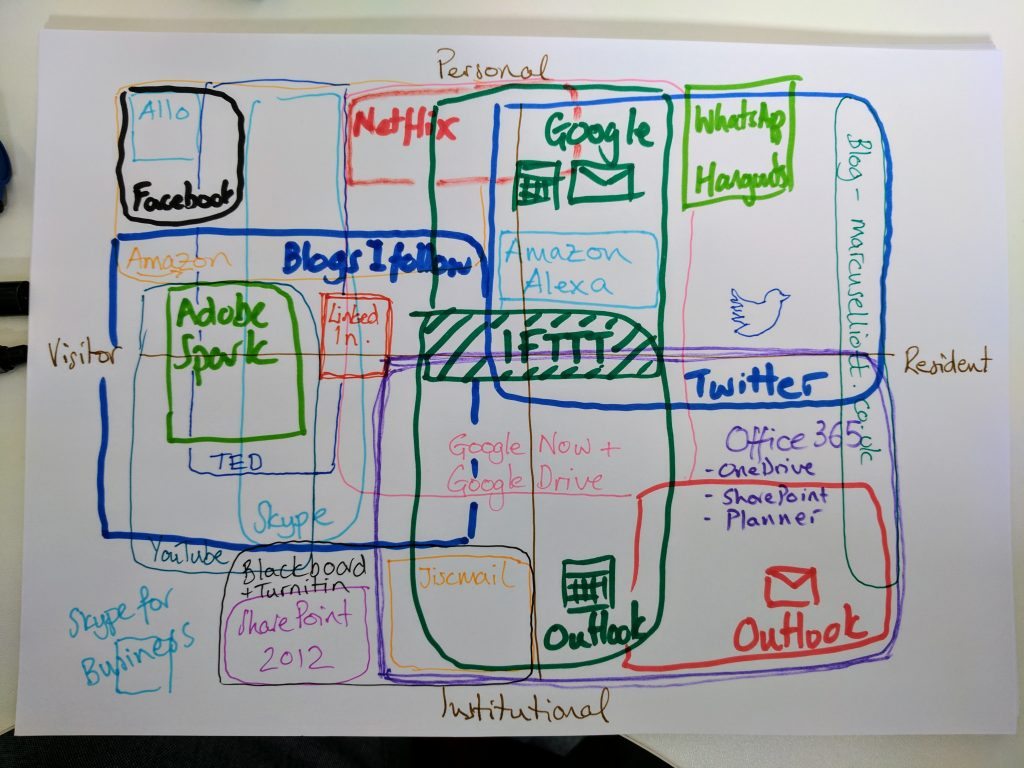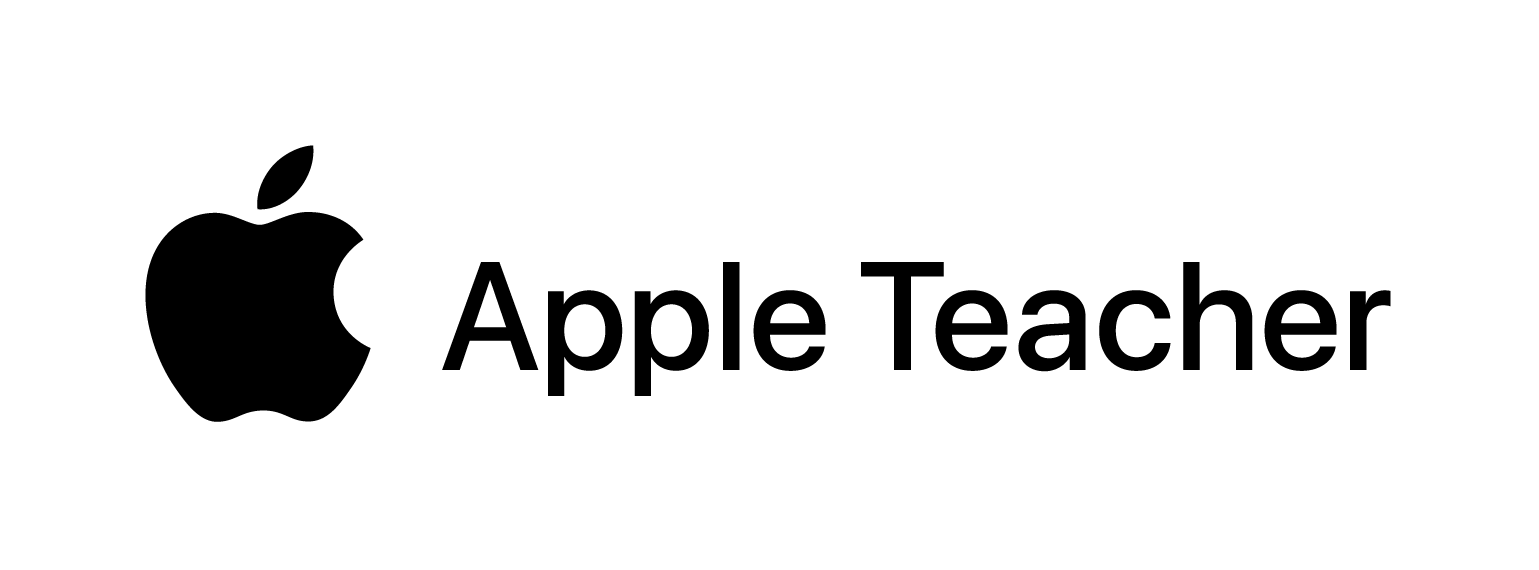Lawrie Phipps recently published a post, “Development not Training: an approach to social media for leaders“, setting out the history and rationale for the VandR mapping exercise he uses on his Jisc Digital Leaders course (VandR is shorthand for Visitor and Resident, a really useful way of thinking about how we engage with our digital lives – see here for a natty cartoon). If you haven’t read his post, please do (but promise to come back). And if you haven’t attended the Jisc Digital Leaders course, I would highly recommend it – booking is available for the May 2017 but I do not get commission.
When I attended to inaugural Jisc Digital Leaders course in late 2015, one of the activities we were asked to do was to map the systems and software we used in our lives onto a VandR matrix. As Lawrie describes, the VandR matrix is made up of two continua: visitor-resident and personal-institutional.
I could dwell on how useful the exercise is in helping you to reflect about your relationships with technology, and about your work and personal lives determine the tools you use, but after reading Lawrie’s post, I thought back to when I did the exercise. So, I looked back through my photos and tweets, and found it.
My digital map #jiscdiglead pic.twitter.com/noZnP09qZU
— Marcus Elliott (@marcuselliott) October 22, 2015
I thought it would be interesting to compare it against now and see if there had been any changes, and, more importantly, reflect on why those changes have occurred. When I mentioned the idea on twitter, I was politely informed I had to blog about it (thank you James Clay).
In October 2015, I think it would be safe that my thinking was very much around how my job could identify and support the use of tools to improve education. I hadn’t really considered my relationship with ‘digital’. Since then, I have talked at some conferences, been highly commended by ALT, and moved to a different institution.
So, I sat down and had a go at a March 2017 VandR map. Here it is (click on the image to see a larger version):

Analysis
Well, the first thing you will notice is that the 2017 version seems a lot busier. I put this down to a lack of quality Sharpies, and the fact I made do with A4 paper, when A2 would have been more appropriate. Once you see past that, some other things become quite noticeable.
New entries
The first thing to notice is the emergence of Office 365 on my mapping. It was rolled out at my previous institution last year, and is also used at Bishop Grosseteste University. I have embraced it fully and tried to use it to support my work. It isn’t without its frustrations, like OneNote not talking to anything, but I have tried to make it central to my professional life.
Blogs I follow: this is a bit of an odd one. I used to read blog posts, but now I am a lot more organised about it. Now I subscribe to some really interesting people’s websites, but I am definitely in Visitor-mode. I rarely comment, and if I do, it is generally through twitter.
IFTTT: I have found IFTTT really useful for streamlining some of my activities. These range from using voice commands to turn lights on at home, to moving data from one system to another. I am exploring how IFTTT (and Zapier) can streamline some of my work processes, to make me more efficient.
Other new things include Amazon’s Alexa service (although I wasn’t entirely sure where to put it on the mapping), WhatsApp (which has replaced most messaging services except Hangouts with immediate family), and Adobe Spark suite
Goodbye to old friends
About.me: I think I had signed up just before the Jisc Digital Leaders course. I never signed in again. This was probably because my own website replaced any functionality About.me provided.
WordPress: In my previous job, I looked after the institutional WordPress network. In my current role, this is less of an issue. I think my relationship with WordPress has changed, and has been replaced by the ‘Blogs I follow’ section.
Other ones to disappear include xkcd, BBC Sport and other entertainment services. This doesn’t mean I don’t use them anymore; I am not sure they are necessarily appropriate for my mapping.
Notable movers
The most notable mover is probably LinkedIn. In my previous job, we were expected to create a LinkedIn profile, as were all students, and there was an expectation we should engage with it. So I updated it, added people I met at conferences, accepted connections from people I’d never heard of, shared content, etc. It was very much part of my outward, professional identity. Now, however, I only go on there when I have a notification. I try to keep it updated, but I haven’t invested myself in it, unlike Twitter or my website.
Skype/Skype for Business: I had a Skype account. I didn’t use my Skype account. My old work encouraged we used Lync (Skype for Business) instead of email for internal comms. However, as Skype for Business is definitely not fit for any purpose, I have pretty much ditched it. I have started to use Skype more often, although that may be because I now don’t have an alternative webinar/video-conferencing tool. My personal Skype account has started to form part of my professional communication ‘system’.
Facebook: I’m not sure why I really keep my Facebook account open. I resent it: I don’t engage with it at all. I think I have posted on there a couple of times since 2015 and I mainly use it vicariously. What might have kept me there is the messaging service, but since it split from the App on mobiles, I don’t want to know.
Jiscmail: This one isn’t a mover, but actually I wish it had. I keep thinking that I should engage with others more through Jiscmail, like I know some of my colleagues (Sue Watling, for example) do very well. There might be a little of Imposters Syndrome here, or not wanting to add to the white noise, I am not sure.
Amazon (shopping): I haven’t written a review in ages. I know. I am a bad person. Since I got Amazon Prime, those oversized boxes keep arriving at the house, so it would be a full-time job reviewing every item I order.
In conclusion
I’m still not sure I did it right, either time. Having to write it with permanent pen made it very difficult to decide where you drew the boxes sometimes. However, I feel like the exercise has been very useful, and especially coming back to it after a year. When we moved onto the institutional lens, I changed the style – I prefer it:
My go at our institutional #vandr map – thoughts? #jiscdiglead pic.twitter.com/Jr8GrrzEIC
— Marcus Elliott (@marcuselliott) October 23, 2015
Revisiting the mapping has led me to consider the purpose of my engagement with some of these technologies. Should I be using them? Are they beneficial? Can I do something better, or quicker, or easier by using something else. Or should I think about my processes in more depth. Should I rely on what the institution provides for me, or should I find what suits me best.
Most of all, the act of reflecting has been useful to help me plan my priorities for my own role and develop a digital strategy within my institution. Undertaking the mapping made me consider my relationship with technology, and that will be invaluable as I embark on developing my colleagues and students’ digital capabilities in the future.
If you fancy doing something similar, I would recommend attending the Jisc Digital Leaders course. It has been invaluable in turning my ideas into actions and making me a more confident practitioner. If you just want to have a go, feel free to share in the comments below or via twitter (Tweet to @marcuselliott).


